|
|
Review of GSM-handset Motorola SLVR L7e
Live photos of Motorola SLVR L7e
Sales package:
- Handset
- Charger
- microSD 64 Mb memory card, adapter (capacity may vary by region)
- User Guide
- CD with software (optionally, varies by region)
- miniUSB data cable(varies by region)
Motorola has been so darn consistent in cloning its very own solutions, like Motorola RAZR V3, which got a successor in the form of an “i”-labeled model and a couple of other look-alikes, that it is now evident – having found a “gold vein” once, the company does whatever it takes to squeeze the utmost maximum out of it, which is the right way of thinking for such iconic products as the RAZR. At the same time, “slim” bar-shaped SLVR has fitted right in as well, having quite good sales, yet not as good as the RAZR’s of course. However within Motorola’s range this solution occupies a valuable spot, for the company traditionally ignores candy-bar-style phones and avoids the mid price-bracket. There the company relies on the line-up’s flagship that is to maintain the sales and rival numerous competing products. And it’s not a big deal to guess that the SLVR is the one fitting this role. First announced back in February, 2005, this handset had been replicated a few time even before it was released, the most famous of the “clones” is BenQ Siemens S68. By the time the SLVR made it to the retail stores, comparable solution had been offered not only by BenQ Mobile, but Fly, VK and other players as well. The finishing blow was delivered by Samsung with its Samsung X820, boasting the world’s slimmest casing. Driven in a corner, Motorola started doing what it was good at – dropping prices for its solution. Indeed, in the sense of price, design and quality of materials used, this price-bracket hasn’t seen a proposal stronger that the SLVR.
However at the end of 2006, a VGA camera onboard is completely out of place – consumers are demanding better quality. That’s why the company came up with an idea to prolong the model’s lifecycle by revamping its software, adding support for long-anticipated EDGE, update the camera module to 1.3 Mpix and enhance the set of pre-installed apps. The updated handset got he “L7e” index and will be followed by the L7x, sporting a new camera module, specifically the one embedded in the KRZR. Quite smart approach allowing the maker to alter everything but design – no one has ever used something like that, though, the fact is, Motorola is forced to carry out this strategy.


The new SLVR L7e measures the same tiny 113.5õ49õ11.5 mm as its predecessors. With no extras onboard it weights 96 grams, while with a SIM card this value increases up to 100 grams (compared to 86 grams of the original SLVR). Nevertheless this difference won’t be unbearable for your hands – in fact, you will feel nothing special, the handset still gives you a tactile feeling of a solid and by no means weightless phone. But again, it’s mostly a pleasant heaviness, and on top of that the cold metal makes all the difference – the casing does feel like made of metal, no tricks here.



The casing’s trim is Metallic Blue, which has been pushed by Motorola in all solutions this season, for example the KRZR K1 and the RIZR Z3. If you wonder whether the L7e’s shell gets soiled in no time, the answer is yes, definitely. On the other hand, it’s doesn’t get excessively dirty, and if you prefer wearing your phone in a pocket, then the L7e will get wiped clean without your help.



The most newsworthy improvements include new software, which is now the same as that used in the KRZR – that’s why there is Return key and two-key (instead of three-key) interface layout. Furthermore, this has impacted the handset’s keypad, being almost a complete replica of the one found on the RIZR Z3. And it’s surely not the bad thing, as it’s easy to work with and will barely cause any hardships. Bold rubber framings make typing phone numbers blindly a breeze. All keys are lit in bright blue, which looks quite stylish and gets on well with its major function at the same time – all symbols are well-visible in various environments. The L7e’s edition for the Russian market features two rows of symbols (Rus and Eng).





The display has been left unchanged and still sports a resolution of 176x220 pixels (30x38 mm) and can show up to 262 K colors. For the type of handsets the L7e belongs to, this screen does well, however many offerings boast QVGA-powered displays nowadays. The picture put up by the SLVR L7e looks sharp, colors are vivid, and owing to TFT technology it doesn’t fade too much in the sun. The screen can show up to 6 text and 3 service lines at a time.
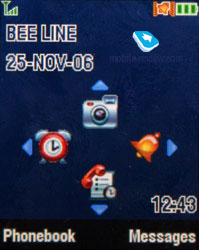
The memory card expansion slot is covered by a rubberized flap, firmly attached to the casing. “Hot swap” works here for any memory card provided that it is microSD (topping out at 2GB today).

The right side features dedicated camera button, doubling as Push to Talk key (in case this feature is enabled in software settings by the user/manufacturer, otherwise it won’t be available even via the menu). Since commercial PTT services are non-existent on the Russian market, the maker didn’t bother itself with including PTT configurations for operators and left everything to the end-user. Another item residing on the right side is miniUSB socket for connecting charger/headset/data cable.

Housed on the left is rocker volume key, while the standard Smart-button is placed slightly below – it performs actions varying by menu you are currently in. Some firmware versions allow for binding it up with voice tags activation or sound recorder application.

On the top end you will find an ambient sensor – one of the highlights of all Motorola’s latest offerings – which turns on or off the backlighting depending on the illumination conditions. Holes for a carrying strap are mounted here as well. The rear would have been completely bald if there wasn’t the 1.3 Mpix camera lens.

Removing the back cover reveals a 880 mAh Li-Ion battery (BK60). As the manufacturer claims, it can put up 350 hours of lifetime in standby mode and provide up to 6.5 hours of talk time. In conditions of Moscow networks the charge on the battery lasted for 4 days at one hour of calls and up to 45 minutes of other functions usage. But you are more likely to end up with 2-3 days of stable operation on a single charge. It takes the SLVR L7e a bit more than 2 hours to charge from empty to full. Should you be heavy on its music capabilities, the lifetime will fall down dramatically to 1 day (4-6 hours of music playback, up to 1 hour of calls).



As compared to its predecessor, Motorola SLVR, the revamped model is better by approximately 25 percent, provided that both handsets are used pretty much in the same fashion. What has allowed the L7e to get this huge benefit? First, a more capacious battery (880 mAh against 820 mAh), but the main credit goes to updated software, consuming less power (about 20 out of 25 percent are generated by the software).
Menu
The handset houses 21 Mb of user-manageable memory, this volume can be expanded with a memory card, where you can keep various applications on. An executable Java file is restricted to 1MB in size (the size of a JAR-file), while the HEAP can top out at 2MB. Actually which memory type is used doesn't matter to the phone when working with files (music, calls, photos, applications), but the interface speed proves to be lower for the internal memory (though it should be vice versa if you come to think of this). This pust a restriction on the bitrate of mp3 files as well. And now the recommended bitrate for the phone's memory is 64 kbps and 128 kbps for the card. However you should treat this statement as recommended by the manufacturer, rather than as a limitation to obey. The phone will play back files with 256 kbps or an alternating bitrate perfectly; problems pop up on rare occasion only for some specific tracks.
Memory for applications is distributed dynamically, 1000 contacts is an assured number of entries that can be saved in the phonebook. An organizer can store up to 500 events and up to 400 tasks (or any combination of them - not more than 900 entries in sum). An MMS is limited to 300 KB in size.
To call up the main menu, you can simply press OK button, located in the centre of the navigation pad. The main menu traditionally features 9 icons; each of them uses information bar for definitions. You can switch the appearance of the main menu to the list mode and then everything will be arranged in plain lists. A half of the submenus is represented as lists and another half as icons (if you choose a corresponding menu appearance). The user may customize the shortcut number navigation, but you can setup shortcuts for almost every menu item or function (including custom ones). For standby mode, the navigation key may call up various applications that are assigned by the user. Further more, you can play around with the options in order to make all icons disappear from the screen until the navi-pad is pressed. Two soft-keys can be bound to various actions as well, apart from the default ones. With such menu flexibility at your disposal the lack of the shortcut number navigation is not that crucial.
 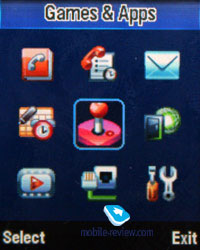
The device supports iTap-powered predictive text input. While typing, the screen displays current words, but hides symbols assigned to the keys.The device remembers the variants of the words you picked and after that offers them automatically. That helps to avoid entering words into the dictionary as it is necessary in T9.
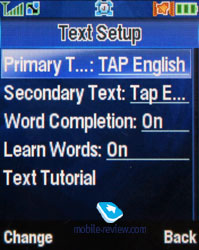
Those using two languages for typing SMS messages will be happy to find out that this option is very manageable on the SLVR L7e. You can also setup which type of text input to use for every language - predictive or not
Phonebook. Not less than 1000 names can be saved in the phone's memory and for each entry you can store First Name and Last Name (two fields), Nickname, phone number (select its type in a list - home, work, mobile, fax and so on, available for videocalls or not). At entering a number you will get only one field, but be sure another one will get highlighted after you fill the given field. That means the phone offers step by step data entry, which seems quite logical. And the last but not the least, up to 7 numbers can be kept for a single contact, which is enough for the majority of users.
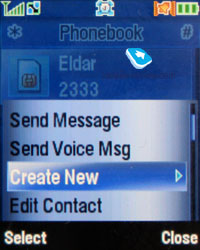 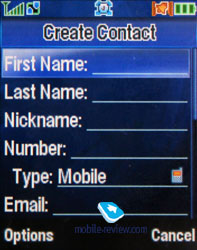
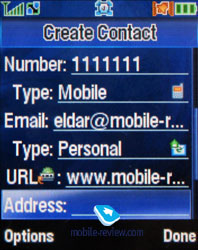 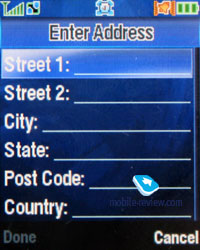
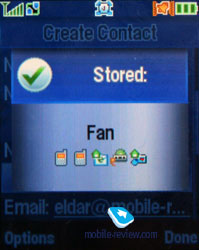 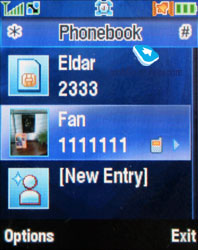
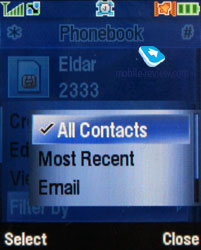 
Apart from telephone numbers you can enter e-mail addresses (up to 2), URL, a postal address (two fields for street, city, state, area code, country). Also we should mention a text note, a personal ring tone, user groups (unlimited number, and each one can have a personal tune), and a birthday. Unfortunately, no reminder on birthday gets scribed in the organizer automatically, no sound signals appear either. I consider it to be the next step in development of the phonebook.
The handset makes use of a speaker-independent voice recognition system, which means no voice tags are required (though they vary by region and selected menu language) – you can dial any contact or call up applications with voice right away. For some markets this handset will come included with disabled speaker-independent voice dial feature, so that users will be forced to record voice tags.
The general list shows names both from the phone memory and SIM (only one type is viewable at once). Search may be carried out by several letters and you can add until a word is complete. Three view modes of the list are available - only names with an icon of a default number; names and photos and the first phone number (a default one); names with a number. Fast scrolling with the help of horizontal presses is enabled on the SLVR L7e. Any number can be added to the fast dial list, so that you can send a message or call a selected number via a pop-up menu.
The groups settings enable you to pick personal ring tones and images for them – the SLVR L7e houses 4 groups by default, though this number can be easily extended by user. Support for mass message sending to group members is onboard.
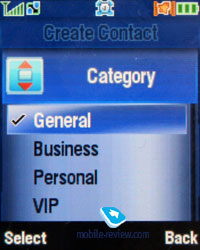 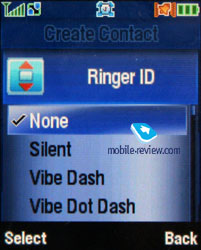
A really appealing addition to the interface is filter by e-mail address (sorting of the general list) or recently used numbers (works for SMS as well) – in the latter case the list is topped by Recent Contacts.
You can retrieve contacts from other phones, which is an attractive capability. And if names coincide, two entries are created. If one of the entries has a Nickname field filled up, then the contact will be displayed under this nickname, rather than under the First Name and Last Name. In fact this is one of the first devices that can receive complete information on contact from another device (for example contacts beamed from Sony Ericsson K800i had assigned photos on the SLVR L7e).
Even despite some possible distortions of encodings for Russian language, synchronization with MS Outlook brings about no problems. We failed in finding the reason why they were so crude, though. However after a complete clean up of all entries and a repeated synchronization, all entries were displayed in normal Russian.
Messages. The default memory capacity for 100 SMS is provided, which may also vary depending on the firmware version. As a rule, operators’ editions are capped to 300 messages. The device can handle EMS if such necessity arises. Automatic cleaning of the whole message list should be mentioned as an extra possibility, as well as a list of templates. Delivery report may be turned on permanently or switched on/off for a given message.
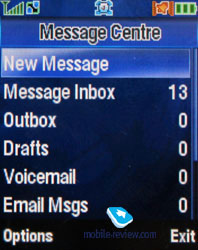 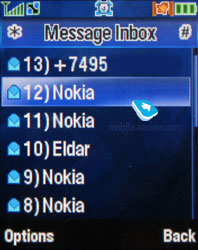
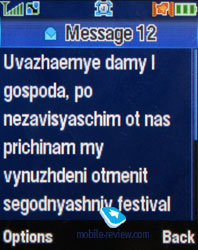 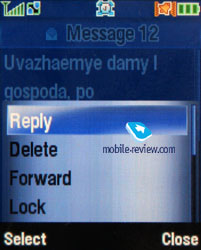
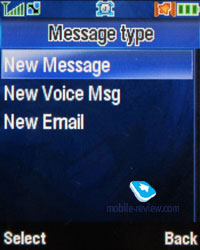 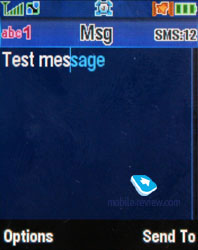

MMS management doesn't cause any inconvenience; everything is simple and easily understandable. The messages can be enhanced with pictures taken with the built-in camera and sound clips. The ten predefined templates are really great, be sure to check them out.
The phone has POP3/IMAP4 e-mail client, allowing watching the headers of the incoming mail and downloading their bodies as well. Only images, video, mp3 that do not exceed a certain size limit can be sent. In case you want to store some of the e-mails, you will have to use the dynamically spread memory, just like in case with MMS.
WAP. The phone has WAP-browser v2.0 and its capabilities are standard so nothing special can be said. EDGE (class 10) is enabled, the settings are rather simple, just follow your operator's instructions.
Recent calls. The handset retains a merged list of calls, which means there you will find both missed and dialed numbers. Using “*” and “#” keys you can seamlessly jump between the lists. Special lists for 40 recent calls are also available.Not only the caller's name but the type of the number is shown, if it is kept in the phonebook. Everything is rather simple and traditional, nothing special at all. Each entry features the date and time as well as the duration.
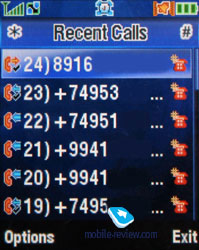 
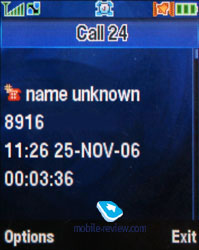 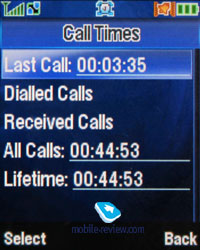
Also this menu shows last calls, call duration and data connections.
Tools. This menu features a whole bunch of office applications such as the Calculator. It's convenient; the full digital keyboard is present on the screen, which reproduces the real keyboard perfectly.
 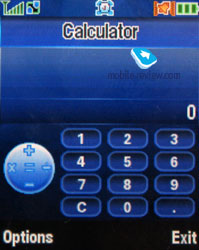
Alarm clock. You can set up several alarm clocks, choose custom ring tones, name and volume, type of reoccurrence (daily, single time) for each of them. This phone was designed for continuous use, that's why entering names and titles for the alarm clocks is required (however you can enter no text, if you like). Alarm clocks are activated in one touch, and a note really makes handling alarms a breeze.
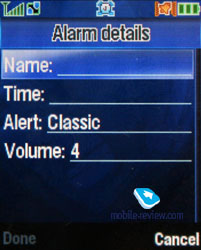
Voice recorder. The recording function can be called up both in standby mode and while calling – in the latter case it records both sides. Maximum duration of a recording is limited only to amount of free space you have on your SLVR L7e. Your interlocutor gets notified if the voice recorder has been started – at first it’s a buzzing sound and then short peeps at regular intervals.
Organizer. You can view it monthly or weekly with breakdown for hours. You will see your appointments bound to a certain time of the day, it's convenient. Each entry can be assigned with a name, start time, length (measured in hours, the minimal amount of time - 30 minutes). Alert can be set up to trigger off before the event (user-manageable). Each entry can set to be recurrent, which is a major attraction.
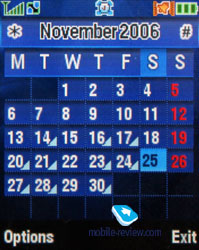 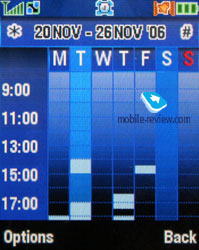
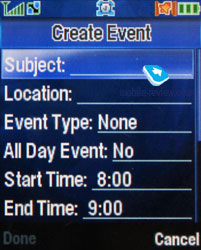 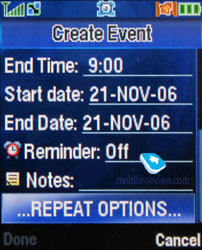
 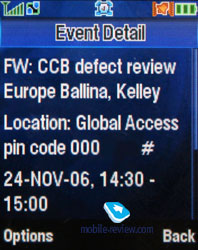
The To Do list is missing in the SLVR L7e.
SyncML support is enabled on the SLVR L7e, which is aimed at enterprise users who are in great need of synchronization with data server (a kind of remote synchronization with Desktop PC, but this time the server must be located in the network).
Activation List – the handset boasts support for DRM 2.0, so that in the Activation list you can check out licenses, their status etc.
World time – shows current time in three different cities of the world.
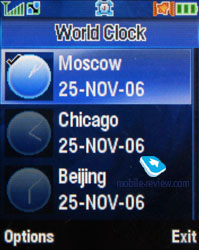 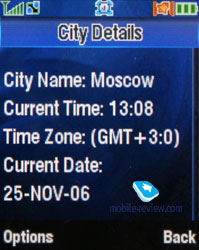
Games and applications. The phone supports Java MIDP 2.0; all applications that are located in this menu item are based on this technology. The number of games and their title depends on where the phone was bought. In most cases you will end up having only MysterryMansionPinball game onboard.
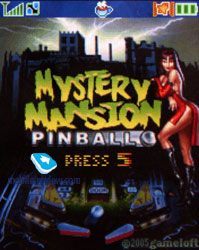 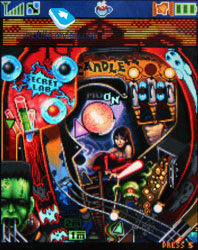
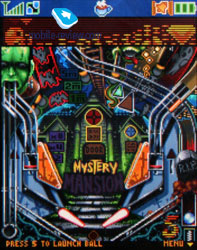
The Applications contain three utilities by Motorola – Motorola Text, Motorola Setup (operator-based setup of the handset), BackUp (uploads your phonebook to the server).
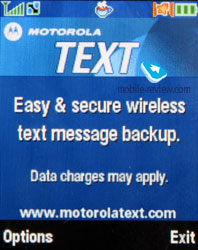 
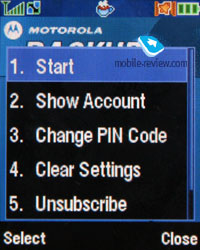 
Some European market will get eBay Pocket Auctions app onboard as well – as its title implies, this program allows handling lots on eBay.
 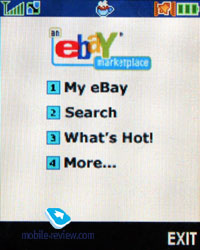
Even though a MP3-player is available, it’s not of much use; since it cannot be minimized, as well as Java-based applications on the whole (Suspend is the only supported feature).
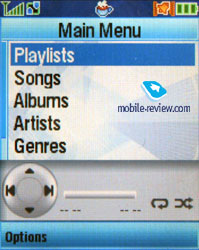 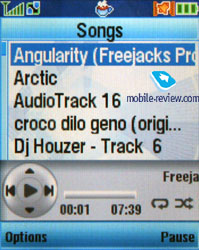
The handsets retailed in Euroset shops might have an optional application going by the name of Jolly - catalogue featuring various types of mobile content.
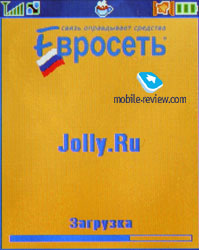 
Multimedia. The phone supports themes. It's a set of wallpapers, color schemes for the menu, sounds and ring tone types. You can change the outlook of your phone almost instantly and this is really amusing. New themes can be downloaded from Motorola's website, but keep in mind there aren’t too many items to pick from.
The number of available skins has been modified and now they look differently as well. They not only change menu color, but the windows as well as the rest of the interface, which is quite nice thing to play around with.
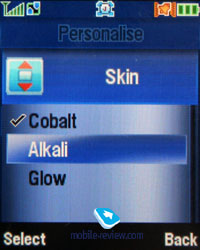 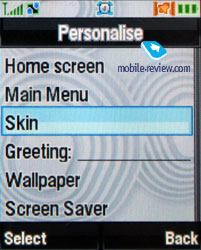
Sounds - information about all sound files stored in the phone's memory is located here. You can check out their size, info and even listen to them. The player found on the SLVR L7e is similar to other Motorola's phones, everything is clear and easy to understand. The great advantage of this very player is playing back mp3's in background mode. You can draw you own play lists with the help of corresponding tools. Support for MP3, as well as AAC and AAC+ is onboard.
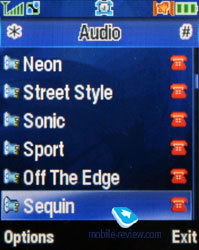 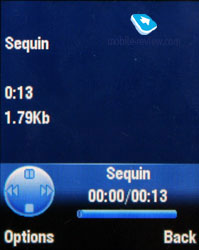
Pictures - list of all images located in the phone's memory. There's a special icon placed next to each file. Every picture can be set as the wallpaper or screensaver. Pictures can be sorted by categories; which makes browsing easier.
 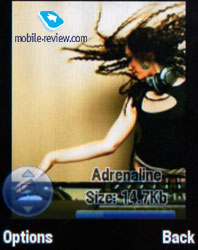
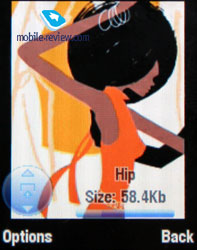 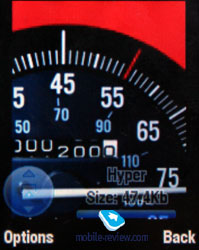
Moreover, you can use a built-in editor, which allows overlaying frames, changing color scheme and using special effects. The most convenient part is that after editing a picture it can be stored with a new name. This means that both the original and the new picture will be available for use. This may come in handy in case you want to edit the photo, and not to ruin the original.
Settings. Here you can setup all Display settings including the color schemes.
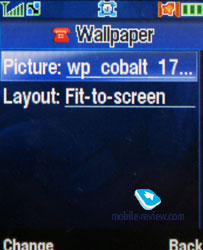
Ring tone type and notification mode (mixed mode, when the silent alert goes off at the same time with the ring tone) is here as well.
 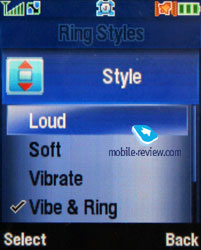
Here you can activate the Flight mode and set an alert on its activation. The fact that profiles are missing on the SLVR L7e frustrates a little, however the Flight mode is the first step towards fully-functional profiles.
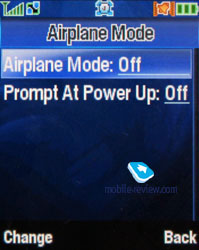
Security settings have been expanded greatly. Now you can protect some functions with a password – be it the phonebook, messages, or some other phone’s sections.
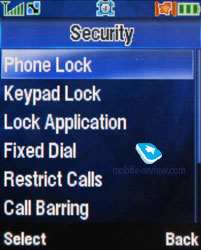
Bluetooth settings were slightly modified; Now, the Print option is available, printing is possible for a message, an organizer note or a phonebook entry.
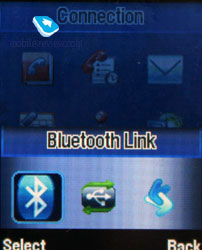 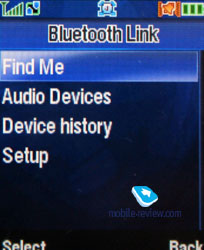
The supported standard is 1.2; apart from the Print profile the handset now can provide Audio Profile (A2DP), which allows pairing up a stereo headset with it. You can't use fast forward feature from the headset; however it will certainly help you to switch tracks. Bluetooth data transfer speed tops out at nearly 25-30 Kb/s.
USB-ñîåäèíåíèå. The SLVR L7e has support for Print profile and USB Mass Storage mode, when it’s identified as a memory card. Data transfer speed is no different from USB 2.0 Full Speed, which is in fact not too much, but is OK for handsets For connection purposes you can make use of a standard miniUSB data cable.
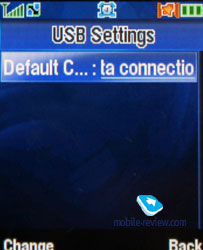 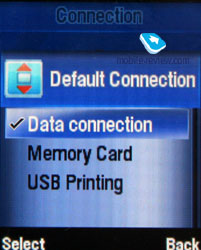
Camera. A 1.3 Mpix camera is integrated into the phone, allowing you to take photos in the resolutions of 120x160, 240x320, 480x640 and 960x1280 pixels. The possibility to switch off the shutter sound, vary exposure from -2 to +2, choose lighting conditions (auto, sunny, cloudy, indoors, office) should be also mentioned. Timer-based shooting support is onboard.
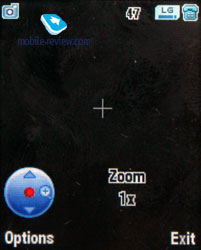 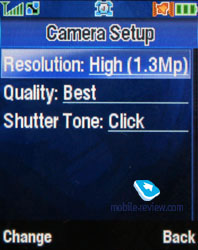
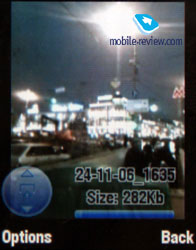 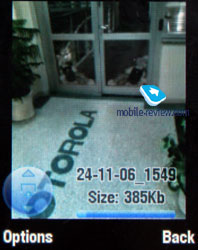
Photos taken in maximum resolution can be saved only to the memory card, while video is stored in the phone's memory. The quality of the CMOS-sensor is mediocre; it screws up in bad lighting conditions, so that snaps get blurry and crude. The best results are achieved in bright sun light and in other cases gamma of the resulting snap is somewhat disappointing. Thankfully, though, when working with the camera the picture is shown full-screen and keys captions are semi-transparent. Lighting settings may be adjusted with vertical presses of the navi button, which is also responsible for choosing effects (color, black and white, blue, oldish, red, green, and negative). There is an 8x digital zoom enabled on the L7e as well.
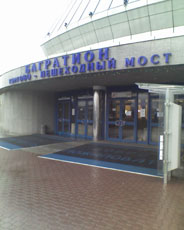 |
 |
(+)
maximize, 1024õ1280, JPEG |
(+)
maximize, 1024õ1280, JPEG |
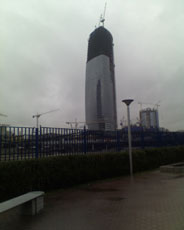 |
 |
(+)
maximize, 1024õ1280, JPEG |
(+)
maximize, 1024õ1280, JPEG |
 |
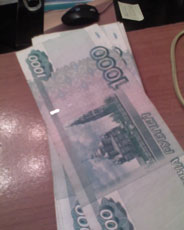 |
(+)
maximize, 1024õ1280, JPEG |
(+)
maximize, 1024õ1280, JPEG |
 |
 |
(+)
maximize, 1024õ1280, JPEG |
(+)
maximize, 1024õ1280, JPEG |
 |
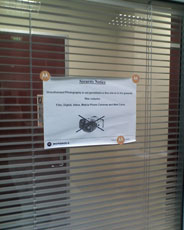 |
(+)
maximize, 1024õ1280, JPEG |
(+)
maximize, 1024õ1280, JPEG |
 |
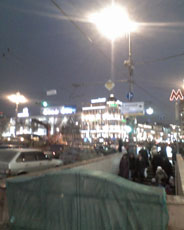 |
(+)
maximize, 1024õ1280, JPEG |
(+)
maximize, 1024õ1280, JPEG |
 |
|
(+)
maximize, 1024õ1280, JPEG |
|
A curious fact – in video recording mode, the interface switches to landscape orientation, so it seems over at Motorola they are working on implementation of widely-used interface layout – for the time being such layout is utilized by Sony Ericsson- and Nokia-branded handsets.
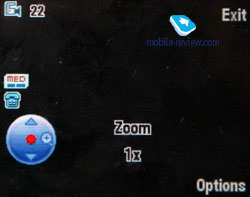
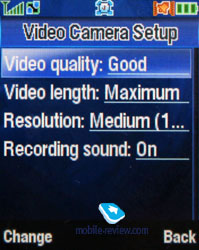
There are three quality grades available for video - good, best, very best. The maximum duration of a single clip makes 10 minutes. What's interesting is that the camera interface differs from the video recording one since it is another menu item. There is a fast settings change but the picture occupies a part of the screen which can be explained with the clip resolution (low - 128x96 pixels, high - 176x144 pixels). The quality of the video is average and sound may be turned off when recording. Frame rate – 15 FPS.
Differences between the SLVR L7e and the SLVR L7
I have stumbled upon tons of questions regarding the differences between these two handsets and whether one should go for a new edition or not. To nip further development of the controversy in the bud, let us list the major distinctions:
- Casing’s trim – blue only for the L7e
- Revamped interface, bringing about new keypad, two-key device management.
- Support for EDGE class 10
- Full functional phonebook
- Enhanced battery life – increased by about 25 percent
- Support for Bluetooth A2DP-profile and stereo-headsets
- 1.3 Mpix camera (better quality provided only by the resolution used)
How vital these adjustments are – it’s all up to you.
Synchronization with PC. A full version of Mobile Phone Tools version 4.x is included into the package (not for all markets – the packages for Russia lack this software). The program capabilities cover the needs of the majority of users: they include synchronization with MS Outlook, making reserve copies on a PC, copying photos, tunes, drawing up messages on the PC. ActiveSync Exchange support is also onboard, though only remote synchronization is provided (with a mainframe via network).
Impressions
The model delivers good receiving quality, typical for all modern devices. Ring tones’ volume is slightly above average, midi-tunes are played back via 64-chord polyphony module, which ensures fairly great sounding. The silent alert is nothing special on the SLVR L7e – it’s somewhere between “average” and “slightly above average” strength-wise. The loudspeaker outputs enough volume during conversations for nearly all environments.
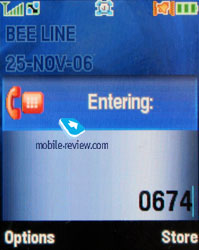 
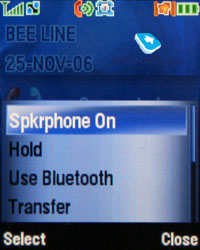 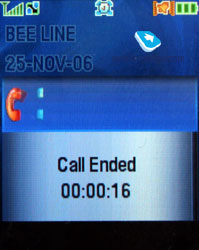
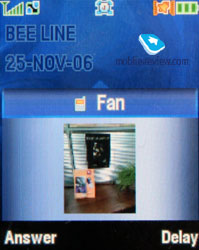
The handset is arriving in the market in December at a price approximately 40-50 USD higher than the SLVR L7’s, in other worlds, the updated model will be retailed for 230-240 USD. For the time being this price-bracket doesn’t host any slim offerings from the market’s best makers, with BenQ Siemens E71 being the only indirect competitor (this handset boasts a better screen, yet plastic casing). The rest of the features, including music capabilities are pretty much the same for both proposals. And that’s about it – apart from the E71, the SLVR L7e is all alone on the market at present.
Going for the revamped handset is fine, if you are in vital need of functions missing on the original SLVR or just you have fallen for the new trim. While having a very affordable price, the new model is truly eye-candy. Definitely this offering will have some good sales, yet it’s not cable of becoming a bestseller in the full sense of this word.
Related links:
Eldar Murtazin (eldar@mobile-review.com)
Translated by Oleg Kononosov (oleg.kononosov@mobile-review.com)
Published — 18 December 2006
Have something to add?! Write us... eldar@mobile-review.com
|
News:
[ 31-07 16:21 ]Sir Jony Ive: Apple Isn't In It For The Money
[ 31-07 13:34 ]Video: Nokia Designer Interviews
[ 31-07 13:10 ]RIM To Layoff 3,000 More Employees
[ 30-07 20:59 ]Video: iPhone 5 Housing Shown Off
[ 30-07 19:12 ]Android Fortunes Decline In U.S.
[ 25-07 16:18 ]Why Apple Is Suing Samsung?
[ 25-07 15:53 ]A Few Choice Quotes About Apple ... By Samsung
[ 23-07 20:25 ]Russian iOS Hacker Calls It A Day
[ 23-07 17:40 ]Video: It's Still Not Out, But Galaxy Note 10.1 Gets An Ad
[ 19-07 19:10 ]Another Loss For Nokia: $1 Billion Down In Q2
[ 19-07 17:22 ]British Judge Orders Apple To Run Ads Saying Samsung Did Not Copy Them
[ 19-07 16:57 ]iPhone 5 To Feature Nano-SIM Cards
[ 18-07 14:20 ]What The iPad Could Have Looked Like ...
[ 18-07 13:25 ]App Store Hack Is Still Going Strong Despite Apple's Best Efforts
[ 13-07 12:34 ]Infographic: The (Hypothetical) Sale Of RIM
[ 13-07 11:10 ]Video: iPhone Hacker Makes In-App Purchases Free
[ 12-07 19:50 ]iPhone 5 Images Leak Again
[ 12-07 17:51 ]Android Takes 50%+ Of U.S. And Europe
[ 11-07 16:02 ]Apple Involved In 60% Of Patent Suits
[ 11-07 13:14 ]Video: Kindle Fire Gets A Jelly Bean
Subscribe
|
















































































































